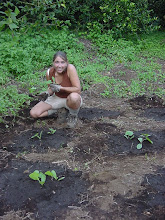However, i am not so arrogant as to assume that the farm is absent of animal life. on the contrary! the place is crawling (literally) with both welcomed and pesky critters. A recent arrival heralding the official beginning of the Dry Season are las chicharras whose music, for me, captures the nostalgia of hot muggy summers.
Annual cicada, Tibicen linnei
Above, see the exoskeleton of a chicharra, its crispy outer shell evidence of its final foray in the chicharra life cycle: molting into an winged adult, after anywhere between 2 to 15 years living underground.
These guys are not known to harm crops, save young fruit trees where females may prefer to lay eggs, so what's all the noise about?
HEAR it is! listen to this video clip, recorded at the farm around dusk. Apologies for the poor visual quality.
These guys are not known to harm crops, save young fruit trees where females may prefer to lay eggs, so what's all the noise about?
HEAR it is! listen to this video clip, recorded at the farm around dusk. Apologies for the poor visual quality.
While i am eternally grateful that chicharras are not the biblical locust plague sent to descend upon my humble garden, and i recognize the VITAL importance of beneficial insects and pollinators, i admit that i am not a huge fan of bugs. That being said, if i had some pics of bees and butterflies i would be eager to celebrate them here, a small slice of internet fame in exchange for providing VIABILITY to my poor little forever-flowering cantaloupes:

Turns out, cantaloupe flowers require pollination for fruit set, otherwise all you get are cute yellow flowers. Sadly, i haven't seen much bee action en la finca, despite the attractive blooms of zillions of flowering "weeds" surrounding the garden. the next step would be something called hand pollination, in which one manually transfers pollen from a male to a female blossom. Call me squeamish, but i'm not sure i'm ok with that? i'm a first-year gardener for crying out loud!
And finally, not to be overlooked, our domesticated yet (occasionally) working farm animals:

Turns out, cantaloupe flowers require pollination for fruit set, otherwise all you get are cute yellow flowers. Sadly, i haven't seen much bee action en la finca, despite the attractive blooms of zillions of flowering "weeds" surrounding the garden. the next step would be something called hand pollination, in which one manually transfers pollen from a male to a female blossom. Call me squeamish, but i'm not sure i'm ok with that? i'm a first-year gardener for crying out loud!
And finally, not to be overlooked, our domesticated yet (occasionally) working farm animals:
You might remember Niña from the compost scandal a ways back, she's a little gal with a keen ear and a fierce bark.
a new addition to the farm, currently compost-forage apprentice to Niña, goofy, scrawny, energetic--this was the best i could do for his profile foto
¡y La Zaya!
Formerly a Californian house cat, Zaya spends 5-10 minutes a week honing her hunting skills in preparation for life on a farm. Pictured here with latest kill








No hay comentarios.:
Publicar un comentario